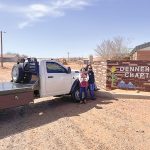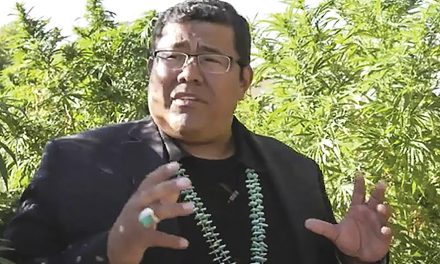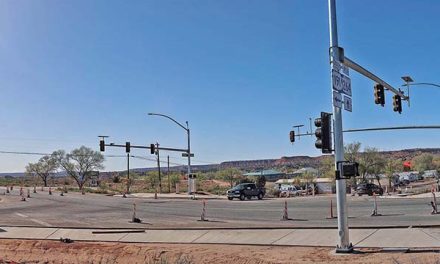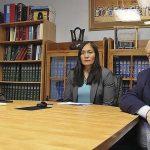
Shiprock leaders unsatisfied with pond cleanup options, want more time
SHIPROCK
Shiprock’s Council delegate and chapter president gave a letter to a U.S. Department of Energy employee Saturday saying they don’t like any of the three alternatives presented for the disposition of an evaporation pond at an old uranium mill site and they want more time to study the situation and present other options.
Delegate Eugenia Charles-Newton and Chapter President Duane “Chili” Yazzie presented the letter to Mark Kautsky, federal project director for the DOE’s Office of Legacy Management, during the second scoping hearing on the fate of the pond, which is used for decontaminating groundwater before it drains into the San Juan River and is nearing the end of its useful life. “Our community has sacrificed much and it is only judicious for us to have ample time to make a complete and informed decision,” the letter reads. “We ask for the public comment period to be extended.”
The letter also protests the cessation of pumping groundwater from the “terrace,” a relatively high, flat area southeast of the fairgrounds where the disposal cell for the mill is located. Kautsky assured the crowd of about 30 that just because the initial comment period ends Oct. 6 doesn’t mean that that will be the last chance to give input. “This (scoping) process goes to early 2020,” he said. “If (a comment) comes in November, it’s fine. If it comes in December, it’s fine. It’s not like we’re going to close the door on comments.” Even after that, he said, the community will have the opportunity to give input on the environmental assessment that will be done on each of the alternatives. The final decision won’t be arrived at until some time in 2021.
“This process is really geared toward working together,” he said. “We want to hear what the community has to say. We want to know what’s important to you.” He added that the alternatives will not necessarily be limited to the three current proposals: to remove the pond and come up with another alternative for treating the groundwater; to replace the pond’s liner and extend the pond’s life another 20 to 30 years; or to take no action.
Option 4
In fact, during a previous meeting the DOE had heard an intriguing proposal from a community member, which was to seal off and bury the pond liner in place “in a manner similar to what the tailings pile is currently in,” Kautsky said.”We’re working on making that Alternative 4.”
In Alternatives 1 and 2, diagrams presented at the meeting indicated pipelines bringing water from the terrace to the pond would be removed, which made some people nervous.
Local attorney Josey Foo said some Shiprock residents had met with Steve Austin, a hydrologist for the Navajo Nation Environmental Protection Agency, Friday and he had opined that any solution should keep the wells on the terrace active. Kautsky explained that monitoring on the terrace had revealed that the mineralization present in those wells was naturally occurring and not part of the “legacy” contamination the DOE is charged with addressing.
Besides that, he said, the terrace wells are flowing at such a slow rate the groundwater they’re pumping barely qualifies as an aquifer. The local Mancos Shale, he said, contains uranium, selenium and nitrate concentrations similar to those in the mill tailings. That’s why the area was mined in the first place.
So how does DOE tell the difference between “ambient” and “legacy” contamination? Through “chemical fingerprinting” of the isotopes in the water, he explained. Foo was unconvinced. “It does look like NEPA’s official position will be to reject all three options,” she warned.
NEPA Not Happy
A phone call to Austin confirmed that.
“At this point, yes, we don’t like any of the options,” he said. “We’re preparing a comment proposing our own alternative.”
Austin said that although there definitely is ambient contamination on the terrace, it’s hard to believe all the contamination is naturally occurring, as the groundwater is directly underneath where the ore pile for the mill used to be.
He agreed that the aquifer is diminishing and hard to pump, but “they have to keep pumping it, I think,” he said. “Otherwise there’s nothing to prevent it from flowing down and mixing with a broken NTUA line or some other source.”
Austin said he would prefer to see a “permanent” solution, such as injecting minerals into the aquifer that would bind the uranium.
“They (DOE) don’t want to be doing this forever, and we don’t want to be dealing with this forever,” he stated. “So I’m sure they’re looking for a more permanent alternative.”
Others continued to state, as they had at the last meeting, that they wanted the entire tailings pile removed, although Kautsky had stated at the last meeting that that option is not on the table because it would take an act of Congress.
No separation
Perry Charley, a Diné College professor and member of the Navajo Uranium Commission, noted that cultural expert David Begay, in his presentation that had kicked off the meeting, had emphasized the relationship between Mother Earth — which could be represented by the tailings pile — and Father Sky — which includes rain and water.
“You say the cell itself and the groundwater are two separate components,” Charley said. “I respectfully disagree … the disposal cell continues to act as a percolator.” Kautsky said that’s not really true. A clay layer and the Mancos Shale underlying the disposal cell are almost impervious. “We do look at the infiltration rate,” he said. “The rate is about 10 to the minus-seventh power centimeters per second.
That is about the same as a garden hose.” Even if the disposal cell is removed, he said, the aquifer already has residual contamination from when the mill was active and will need continued treatment — and one way or another, a decision will have to be made about the evaporation pond.
Russell Tallbull, who said he worked for a company that did remediation in the Cove, Arizona, area, asked some technical questions: How “hot” is the sludge being collected on the pond liner, how deep is the contaminated aquifer, and “Do you (DOE) have any experience removing an evaporation pond?”
The material is not terribly dangerous, Kautsky responded, adding “We don’t believe it will tip the measuring stick for hazardous material” — although the workers removing it will have to wear some protective clothing and be scanned with a hand-held Geiger counter before they leave work each day. The aquifer is 10 to 15 feet deep. And yes, the DOE has removed a similar evaporation pond near Durango, Colorado, so “it’s in our wheelhouse.”
How dangerous?
Others wanted to know how dangerous the situation is currently. Kautsky said that, thanks to a seven-foot-thick barrier overlain with cobble, the radiation level at the disposal cell is about the same or lower than that for the region in general. The mineralization in the San Juan tests about the same upstream and downstream from the pond, and anyway the river is not used for Shiprock’s drinking water supply.
If the pond is removed (Option 1), a number of sub-options is available for treating the groundwater, Kautsky said. Minerals can be injected into the aquifer to slow the movement of heavy metals like uranium; an underground barrier could be erected to keep the water from flowing into the San Juan; an ion exchange plant could be built to treat the water and return it to the ground; or they could use “phytoremediation” — planting four-winged saltbrush and other plants that have been found to remove uranium from the soil.
Charley offered his expertise on the latter, saying his graduate students had done experiments in phytoremediation. Yazzie and Charles-Newton both said that it’s paramount to them that people with traditional knowledge be involved in the decision-making process. “However we reach those conclusions, we need to be an equal at the table,” Yazzie said. “I put forward these ladies and gentlemen of knowledge to interface with your scientists to find the best option.”
Information: https://www.lm.doe.gov/shiprock/Sites.aspx. Comments may be sent to Shiprock Evaporation Pond, c/o Navarro Research and Engineering, 2597 Legacy Way, Grand Junction, CO 81523; left by voicemail at 970-248-6001; or emailed to ShiprockEvaporationPond@lm.doe.gov










 Highway 264,
Highway 264, I-40, WB @ Winslow
I-40, WB @ Winslow